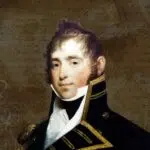Don’t Give Up the Ship Day is celebrated every year on June 1 in remembrance of the U.S.S. Chesapeake’s commander, Captain James Lawrence. The day’s purpose is to honor the ship’s crew and its captain, who refused to surrender the ship to the British and remained on the ship until his death. Although there are different accounts from different sources about the incident, Americans celebrate it as a remarkable display of bravery and gallantry of its naval forces.
History of Don't Give up the Ship Day
The U.S.S. Chesapeake was a naval war frigate intended to carry 40 guns and was one of the six frigates readied under the Naval Act of 1794. The short career of the ship started from the Quasi-war with France in 1799. Without any action since its launch, the ship was assigned to Master Commandant Charles Gordon in 1807.
The first assignment was to relieve the existing ship at the Mediterranean Sea for patrol and convoy duties, but before that, the ship needed a new crew and some repairs. During the recruitment, Gordon unknowingly recruited three deserters from the British H.M.S. Melampus. Historians often argue on whether Gordon knew if he was recruiting deserters, but it certainly was a reason why the British attacked it later on.
In May 1807, the Chesapeake left for Virginia from Washington and, as this news reached the British, a plan was devised to intercept it on the way near Boston. The British ships, led by H.M.S. Leopard, which provided a blockade to French ships at the time, intercepted the Chesapeake at sea. The lieutenant of Leopard asked to search the Chesapeake for deserters, which was refused. The moment the lieutenant unboarded the ship, Leopard started firing at it, as per the plan. In the ensuing battle, the Chesapeake suffered heavily, being unarmed.
After the court-martial of the commanding officer, Captain James Lawrence became the new captain in May 1813. In his initial successes, he managed to capture five British merchant ships using Chesapeake. Within days, he was challenged by H.M.S. Shannon, commanded by Captain Philip Broke. The Chesapeake was attacked from all directions, and the ship became a battlefield as British sailors boarded the ship. In the heavy fighting that ensued, around 72 people were killed, including the fatally injured captain of Chesapeake, James Lawrence. Despite all the losses and his own injuries, the captain remained dauntless and gave his famous orders “Don’t give up the ship,” before finally succumbing to his injuries, after which the Chesapeake was taken over by the British on June 1, 1813.
Don't Give up the Ship Day timeline
The act intends to make six new capital ships for the navy to protect American interests at sea.
To retrieve the deserters, the British frigate Leopard attacks the Chesapeake.
The battle to take over the Chesapeake begins, and Captain James Lawrence is fatally injured.
Thomas Jefferson expresses his anger over this unprovoked aggression by banning all British warships from American ports.
Don't Give up the Ship Day FAQs
Why was the U.S.S. Chesapeake so important?
Being one of the original six frigates commissioned in 1799, the task of every frigate was to provide superiority to the U.S. against foreign aggressors. Chesapeake had similar importance.
Was the U.S.S. Chesapeake poorly made?
The Chesapeake was not poorly made, it was poorly used. It was never fully utilized to its full potential and poor decisions landed it in enemy hands.
When was the Chesapeake decommissioned?
In 1819, the ship was broken and sold for timber.
How to Observe Don't Give up the Ship Day
Visit a Naval Museum
You can visit a naval museum and learn about the history of the American Navy. Learn about how it established its superiority on the seas.
Take a ride on a boat
You can ride on a boat while recalling the story of James Lawrence. Better yet, be your own captain!
Make it life’s motto
The lesson from the act is to stay brave and gallant. “Don’t give up the ship” can easily be translated into “don’t give up on your dreams.” See what resonates with you.
5 Important Facts About Don’t Give Up The Ship Day
It’s more than just five words
These words have become legendary and hold a lot more value in the navy.
It’s a battle cry
It is a battle cry before every football game in the U.S.
It’s a battle flag
These five words written on a blue background became a battle flag for Commodore Oliver H. Perry.
There is also an anticlimax
Despite all the heroics, there is a greatly opposing anticlimax of this story as well.
It’s a valuable lesson
The defeat at Boston taught many lessons to the American Navy that proved valuable in future battles.
Why Don't Give up the Ship Day is Important
It’s a moment to celebrate our heroes
Nations are built by heroes who did something remarkable for their people. Such celebrations remind us of their heroics and bring us together to learn from their examples and do something exemplary ourselves.
A day to rebuild
These words are not exclusive to the navy. They can be the building blocks for the lost and hopeless. It gives them a cause to stay determined and to believe in themselves — that they can endure the existing pain only to emerge successful in the future.
It teaches bravery
The Captain’s last words to his crew were “Don’t give up the ship.” Staying brave and fighting the enemy despite knowing that the enemy is stronger and death is imminent is an act of valor. One can take valuable lessons from this and make them a way of life.
Don't Give up the Ship Day dates
| Year | Date | Day |
|---|---|---|
| 2026 | June 1 | Monday |
| 2027 | June 1 | Tuesday |
| 2028 | June 1 | Thursday |
| 2029 | June 1 | Friday |
| 2030 | June 1 | Saturday |
















































































































